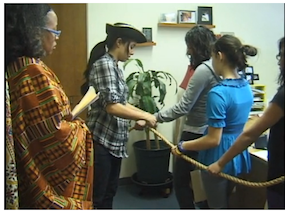A Short Film about the Road to Racial Justice
Kesa Kivel is a facilitator and filmmaker living in Los Angeles. Her short film Never Give Up: Ama’s Journey to Freedom on the Underground Railroad (color, 28 min.) blends an original story, illustrated with drawings and primary source material, with contemporary scenes featuring middle school girls who act out portions of the story line. Never Give Up received favorable reviews from the School Library Journal and Video Librarian magazine. In this article for MiddleWeb, Kivel describes the making of the film. (Watch the movie below and order a free DVD.)
The idea to create an Underground Railroad project, on which the film Never Give Up! Ama’s Journey to Freedom on the Underground Railroad is based, came from a National Women’s History Project curriculum. Their suggestion to stage an Underground Railroad reenactment seemed to demand of me — in large letters in my mind — KESA, YOU MUST DO THIS!
Highly motivated, I decided to create an Underground Railroad reenactment for youth in the after-school program at the YWCA Santa Monica/Westside where I volunteer. The script for the reenactment features a girl named Ama who is kidnapped from Africa and shipped on the Middle Passage away from her family, friends, and country to the harsh realities of slavery on a South Carolina plantation. Middle and high school students as well as adult volunteers participated in the project. The film weaves live footage of the reenactment with historical photographs and original illustrations commissioned for the film.

I felt moved to write a script about slavery with this in mind, but I questioned whether I, as a white woman, should be writing about this powerful and painful aspect of black history.
With the National Women’s History Project “call to action” ringing in my ears, my emotional resonance with the subject matter, my willingness to research the subject extensively, and help from both a multiracial adult focus group (comprised of friends, YWCA staff, and community members) and youth focus groups, I felt that I could co-create a good project and, later, a good film. Both the adult and youth focus groups offered invaluable advice and hundreds of suggestions, many of which I used.
The adult advisory focus group first met five months in advance of the one-day project, then continued meeting throughout the two and a half years of film editing and production. Suggestions from the adult focus group included: change Ama from the light-skinned house worker in my original script to a dark-skinned field worker, provide sufficient psychological motivation for Ama to endure the hardships she faced, and make sure that the project and film were positive and affirming as well as historically sound.
Suggestions from members of youth focus groups included: provide additional motivation for Ama’s and Ben’s burning of the master’s shed, add more suspense to the woods scene, and offer information about Ama’s and Ben’s lives once they reached Canada.
Never Give Up! Ama’s Journey to Freedom on the Underground Railroad (hi-res version) from Kesa Kivel on Vimeo.Read a story about this project at the website of funder Liberty Hill Foundation. Download the film or request a free DVD here.
Enslaved Africans were not helpless victims
As we moved ahead, I knew that I needed to decide how best to frame the story. I was aware that both African American and white students are often uneasy when studying the difficult subject of slavery, especially if the study material gives a narrow representation of each race as exclusively victim or oppressor. During my research for the project and film, I was especially moved by the insightful book Why Are All the Black Kids Sitting Together in the Cafeteria? by Beverly Daniel Tatum.
In the book, Tatum writes,
Too often I hear from young African American students the embarrassment they have felt in school when the topic of slavery is discussed, ironically one of the few ways that the Black experience is included in their school curriculum. Uncomfortable with the portrayal of their group as helpless victims—the rebellions and resistance offered by the enslaved Africans are rarely discussed—they squirm uncomfortably as they feel the eyes of White children looking to see their reaction to this subject.
Could I portray a different kind of story about the Underground Railroad and slavery by emphasizing the resistance of enslaved people? The topic is harsh no matter how it is framed, but with this question in mind, I wrote the script to highlight the everyday, incredibly brave resistance efforts of individuals who were enslaved. My aim was to ensure that African Americans would not be portrayed exclusively as victims.
For instance, in the film Ama is shown actively resisting her kidnappers while aboard the slave ship, crying out:
“‘Mother! Mother! Are you still alive?’ I try to jump off the ship and swim back to my village, back to her, but a man on deck pulls me back. In my sorrow and desperation I struggle to imagine her saying to me, ‘No matter what, never give up!'”
Of her life on the plantation, Ama says,
“How can the master believe that our skin color makes us less than human? How can he not know that we can think and feel just like anybody else? Brown as earth or black as night, we’re all worthy, though he treats Ben and me — all of us — like animals. So I fight back by working slower than I’m supposed to, burying farm tools, stealing food….”
What do students need to know about slavery?

What do students really need to know about slavery? They need to learn historical details about slavery as a felt experience that both impacts and empowers them. A high school teacher commented:
The film, without sugarcoating the painful details of the Atlantic Slave Trade or the brutal life of slavery, is still able to be life-affirming and inspiring. That is a remarkable feat, and an essential one, if we are going to keep young people engaged and connected to the learning experience rather than shut down and demoralized.
The topic of slavery is demoralizing by its very nature, but the story of the human spirit is not. Even in the worst of circumstances, Ama remains hopeful that positive changes will occur — and that she can help make them happen. Although there is no fairy-tale ending to the story, the timeless message of hopefulness that Ama conveys is uplifting and important for contemporary youth to embody. Just as Ama does in the film, today’s youth can make a difference in the world. It is my hope that Never Give Up! will help inspire them to do so.
NOTE: Bonus material includes footage of an adult focus group session (Making of the Project), as well as information on post-slavery racism and how to challenge it (Underground Railroad: Part 2).
__________
Kesa Kivel received the 2011 YWCA Focus Award honoring exceptional women who inspire and empower other women. Contact her and request a DVD of this film (free to educators) at www.nevergiveupfilm.org. Also learn about the free board game Road to Racial Justice.































